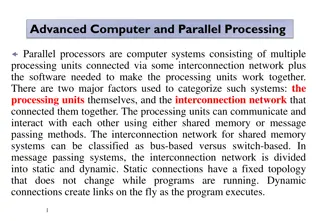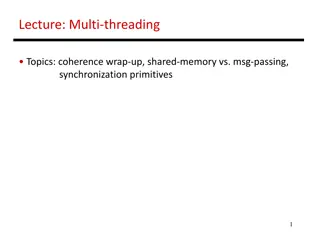Parallel Processing and SIMD Architecture Overview
Parallel processors in advanced computer systems utilize multiple processing units connected through an interconnection network. This enables communication via shared memory or message passing methods. Multiprocessors offer increased speed and cost-effectiveness compared to single-processor systems
3 views • 24 slides
Understanding Multi-Threading Concepts in Computer Systems
Exploring topics such as cache coherence, shared memory versus message passing, synchronization primitives, cache block states, performance improvements in multiprocessors, and the Ocean Kernel procedure for solving matrices.
0 views • 22 slides
Understanding Concurrency in Computer Science
Concurrency in computer science involves running multiple threads or processes simultaneously, providing responsiveness, managing I/O devices, and improving performance by utilizing multiprocessors. This concept allows programs to handle tasks more efficiently and effectively through parallel execut
0 views • 32 slides
Understanding Multiprocessors and Memory Hierarchy
Explore topics such as snooping-based coherence, synchronization, consistency, virtual memory overview, address translation, memory hierarchy properties, TLB functionality, TLB and cache access considerations, and cache indexing strategies in multiprocessor systems.
0 views • 22 slides
Understanding Shared Memory Architecture in Embedded Computer Systems
Explore the fundamental concepts of coherence, synchronization, and memory consistency in embedded computer architecture. Learn how shared memory multiprocessors handle issues like cache coherence, and discover the importance of enforcing coherence with protocols like snooping and directory-based ap
0 views • 53 slides
Multi-Product Chip Multiprocessor Floorplan Optimization Framework
This research discusses a framework for optimizing floorplans of chip multiprocessors, considering multiple products with varying requirements. The study emphasizes the interdependency between interconnection networks and floorplans, impacting power, performance, and area. By making floorplans chopp
0 views • 31 slides
Understanding Computer Architecture: Shared Memory Systems
Shared memory multiprocessors in computer architecture involve multiple threads using shared memory for communication, with synchronization complexities and implicit communication challenges. Despite these drawbacks, Shared Memory Systems have proven to be successful machines due to their evolutiona
0 views • 40 slides
Understanding Multi-Processing in Computer Architecture
Beginning in the mid-2000s, a shift towards multi-processing emerged due to limitations in uniprocessor performance gains. This led to the development of multiprocessors like multicore systems, enabling enhanced performance through parallel processing. The taxonomy of Flynn categories, including SIS
0 views • 46 slides
Understanding Memory Models in Computer Architecture
Memory models in computer architecture dictate the legal behaviors of multiprocessors and play a critical role in ensuring system reliability and performance. They balance definitional simplicity with implementation flexibility, impacting optimizations and overall system design. This article explore
0 views • 26 slides
Understanding Threads and Concurrency in Programming
Exploring the concepts of threads and concurrency in programming, this content delves into the benefits of concurrent programs, different views of processes, and the distinction between threads and processes. It highlights the significance of managing I/O devices, utilizing multiprocessors for enhan
0 views • 31 slides
Memory Model Sensitive Analysis of Concurrent Data Types
This doctoral dissertation defense presentation discusses the CheckFence method as a valuable tool for designing and implementing concurrent data types to address bugs in multi-threaded software executions. It focuses on the problem of relaxed memory models and the need for memory ordering fences to
0 views • 61 slides










